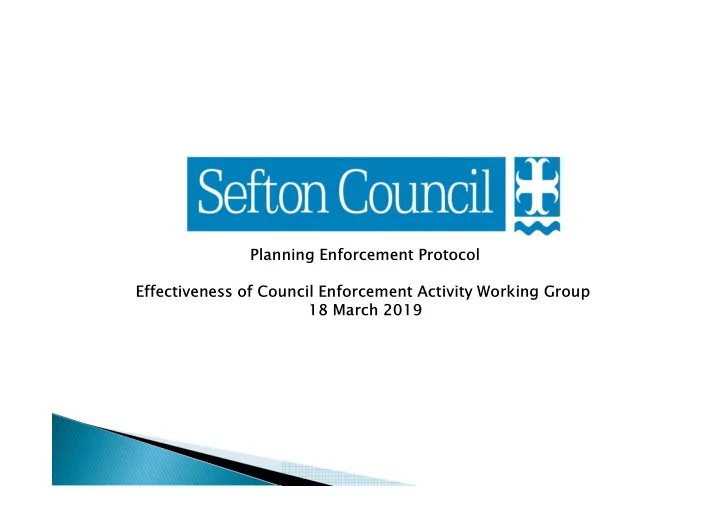

Planning Enforcement Protocol Effectiveness of Council Enforcement Activity Working Group 18 March 2019
� Planning law - control the development and use of land and buildings in the public interest. � Not intended to protect the private interests of one person against the activities of another. � Carrying out such development without planning permission is not a criminal offence. � A measured and proportionate response is required. � Where serious harm occurs, the Council will take firm action quickly.
� Does the breach of control unacceptably affect the quality of life? - Enforcement action should only be taken when it is necessary, expedient and in the public interest to do so. � Action should not be taken just because development has been undertaken without planning permission. - There are no extra sanctions or penalties that can be applied in such circumstances � The Council does not always have to take action - BUT the particular circumstances of the case will always be considered. � We have a high caseload that cuts across every aspect of planning and operate with limited resources. - We therefore must have a way of prioritising our work.
Direct noise, nuisance or disturbance from source � In-direct danger and disturbance e.g. traffic problems � Impact on amenity - Loss of privacy and impact on outlook, � overshadowing and loss of natural light etc. Impact on visual amenity e.g. poor design/inappropriate � materials/neglected/untidy areas Loss/damage to of protected trees � Loss/damage to Heritage assets � Risk of pollution that affects people and/or the natural environment � Developments that undermine Planning Policy �
� Priority A ◦ when irreversible and serious damage to the environment or public amenity would result � Priority B ◦ when less immediate but still potentially serious and harmful to the environment or public amenity � Priority C ◦ when less likely to cause serious or lasting harm to the environment or public amenity � Priority D ◦ When unlikely to cause serious or lasting harm to the environment or public amenity
Priority A Cases Priority B Cases Respond to 100% of cases Respond to 90% of cases within within 1 working day 15 working days Priority C Cases Priority D Cases Respond to 85% of cases within Respond to 80% of cases within 26 working days 40 working days
Acknowledge 100% of all Endeavour to resolve at least complaints within 5 working 75% of all cases without the days need to take formal Enforcement Action Action at least 75% of all cases Generate at least £25,000 from requiring formal Enforcement retrospective planning Action within 13 weeks applications where this will regularise a breach in control
� Main approach is to negotiate a resolution without the need to take formal enforcement action: ◦ Most cases can be resolved by negotiation ◦ Huge cost savings to the Council (£10-30K per case)+/- ◦ Fee generating � Planning Contravention Notice (PCN) � Enforcement / Breach of Condition Notice � Stop Notice � Injunction � Prosecution � Recovery – Charges on Land / Proceeds of Crime
� A breach in planning control is deemed NOT to have occurred. � Reach the conclusion that it is NOT expedient to take formal enforcement action. � The offending party DISCONTINUES the breach and makes good the land by negotiation. � The offending party DISCONTINUES the breach voluntarily during investigation. � The offending party makes a RETROSPECTIVE planning application to regularise the breach � Formal enforcement ACTION is taken
� Clearly defined procedure � Set out the information we need to assist the investigation: ◦ Name and address of complainant ◦ What is happening ◦ When is it happening ◦ Evidence collected ◦ How is it impacting on them ◦ What they want us to do about it � Make clear we don’t respond to anonymous complaints � Treat complaints in strict confidence � Make clear how we will communicate with complainants going forward
� Be clear on the critical tests of Enforcement � Understand the effects of unauthorised development – keep in perspective! � Understand the range of powers available and when to use them � Resources and skills – realistic targets � Make it clear on how to report potential breaches and how we will respond � Prioritise the workload based on harm � Communicate with stakeholders
Questions?
Recommend
More recommend